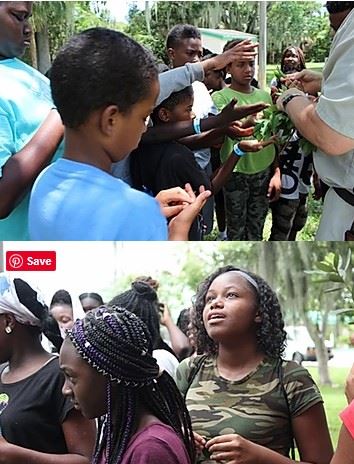Broward County Parks & Recreation STEAM in Parks
Experiential Social Media and Program Efficacy
Ms. Attiyya Atkins and Dr. John Pipoly
Over the last year, Broward County Parks and Recreation has worked to increase visibility, diversity, equity and inclusion in its STEAM programs throughout its Parks. With 17 regional and 8 neighborhood parks, 22 natural areas and 4 nature centers, parks' environmental educators have hosted over 90 programs to schools, tour groups, hobbyists, volunteers, home-schooled children, seniors and special populations. From Nature Tots, preparing toddlers for pre-school from 2 to 5 years old, to senior citizen veterans working to set up areas for reflection, solace, and learning about our environment, STEAM is meant to reach everyone.
Experiential Social Media
Our agency is considering taking these STEAM initiatives to the next level with the unique addition of experiential social media, or the live transmission of learning activities on YouTube and Facebook Live. Our agency’s recommendation is to use these mediums to coordinate and share learning experiences among similar classrooms spanning different schools within the same district. The idea would be to create a short series of experiential science lessons in the living laboratories and classrooms found in our parks, which are available for broadcast.
To illustrate, imagine four 7th grade classrooms in different parts of the county that have agreed to participate in a Living Laboratory Virtual Experience. The four teachers each choose a park to visit for a hands-on lesson with their students. While in the park, the class will learn about their environment, animals, and human systems, as instructed by a park environmental educator. This lesson will be simultaneously broadcasted on Facebook Live, YouTube or another video streaming service, to the three other schools that agreed to partake in the Living Laboratory Virtual Experience. The benefit of this is three-fold, the teachers in the school can receive environmental education within their district without leaving their classroom, the teachers in the field can incorporate highly effective experiential learning into their curricula to appropriately engage students, and park agencies can spread environmental education lessons to a wider audience.
It is ideal for all four participating classrooms to have some artifacts to examine, touch and interpret, whether in the field or receiving a virtual lesson. All four classes would also conduct a pre- and post- survey to monitor their knowledge on each instruction.
When the fourth class is finished with their live instruction, a review of all the principles taught should be conducted. With the assistance of social media, the classrooms can remain in contact with each other to compare their environmental projects, activities, and initiatives. In this way, experiential social media can engage each participating class, provide resources for underserved populations, and increase science and resilience dialogue among our youth, who will become the stewards of our natural heritage tomorrow.
STEAM Program Efficiency
In addition to our experiential social media plans, Broward County Parks and Recreation continues to introduce new populations to environmental education through STEAM. Recently, we conducted a STEAM walk through Reverend Samuel Delevoe Park with the students enrolled in the park’s free summer camp. Reverend Samuel Delevoe Park is in an underserved part in Fort Lauderdale, and this was the first time any of these students had a STEAM class outdoors, away from a formal classroom setting.
Our methodology included taking out two groups of 20 students each, showing them the wonders of nature in their own backyard, including details on various plants, their historic uses, spiders, reptiles, and birds, the encroaching mangrove, and pond habitats. We used the opportunity to talk about mangroves moving up canals due to sea level rise, altered flowering and fruit times, unusual animal migration and mating times, and other phenomena associated with climate change that surrounded them. They also learned about some key organisms such as the Golden Orb Weaver, Carolina Willows, Red Bay trees and its introduced invasive pest, as well as Red, Black and White Mangroves. A post event survey revealed that every student, without exception, commented on the Weaver Spider, the Willows, and the importance of plants to their environment.
Our results suggest that youth of all backgrounds absorb much more information through a field experience, whether virtual or in person. Students who participate in our STEAM in Parks program are anxious to share what they have learned with their families, friends, and neighbors. With the addition of experiential social media, we believe that learning can be greatly enhanced. We suggest that environmental education can make great leaps through this medium and put environmental education right on our students’ smartphones. By reaching them in this manner, we are instilling positive attitudes toward the environment and giving us hope for our next generations
